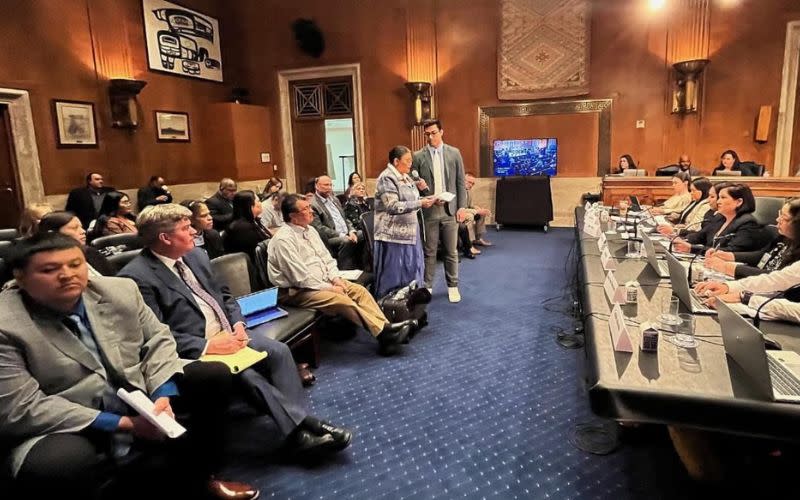Inadequate Funding for Public Safety on Indian Reservations is a Crisis Indian Country, Tribal Leaders Tell Senators

OPINION. The Navajo Nation, which covers some 27,000 miles, has only 214 law enforcement officers and just three criminal investigators.
With a population nearing 400,000, the Navajo Nation is home to 661 registered sex offenders. Between 2019 and 2022, there were 233 instances where cases were not pursued by federal prosecutors, including 75 involving child sexual assault and 44 related to murder or attempted murder.
These statistics about the Navajo Nation were presented as part of the testimony made last Wednesday by the chair of the Law and Order Committee, Navajo Nation Council Delegate Eugenia Charles-Newtonbefore the Senate Committee on Indian Affairs during its hybrid listening session, entitled “Public Safety & Justice Resources in Native Communities.” Charles-Newton said a large problem in public safety on the Navajo Nation is in attracting and retaining law enforcement personnel due to noncompetitive wages and benefits when compared to neighboring jurisdictions. She highlighted the disparity in pay between tribal officers and their federal counterparts, indicating that tribal law enforcement officers and criminal investigators are not compensated at the same level as federal employees, even though they perform comparable duties.
Charles-Newton was just one of dozens of tribal leaders and law enforcement officials who were given three minutes to speak during the three-hour listening session. Throughout the long listening session, those giving testimony spoke of the inadequate funding, high rates of drug crimes, and lack of prosecution by federal officials of those arrested for committing violent crimes throughout Indian Country.
National Congress of American Indians President Mark Macarro, chairman of the Pechanga Band of Luiseño Indians, testified that there is so much need relating to public safety and justice in Indian Country, he did not know where to start. He called the situation an acute crisis that has been going on for decades. He blames the crisis on inadequate funding.
Macarro cited the federal standard for officers is 2.4 per 1000 people. The Oglala Sioux Tribe on the Pine Ridge Indian Reservation in South Dakota has 0.6 officers per 1000 people.
“There's 56 million acres in Indian Country and given there are a handful of officers on patrol and every call for service — Missing and Murdered Indigenous Persons (MMIP) and other series of crimes, such as fentanyl and those committed by cartels — every call for service has an extended response time. It's unacceptable. Every non-Native in any community in the United States wouldn't accept what's happening in Indian Country and something needs to be done about that,” Macarro said.
Macarro, who first called for a national public safety and justice summit during NCAI’s State of Indian Nations address in February, said there needs to be deep discussions about jurisdictional and law enforcement needs on our tribal lands and police brutality in our urban tribal communities.
“Unless we get robust funding from Congressional appropriations, this crisis will continue,” Macarro said.
Stockbridge-Munsee Band of Mohican Indians President Shannon Holsey, who also serves as the president of the Great Lakes Inter-Tribal Council and as co-chair on the Violence Against Women (VAWA) task force, testified the public safety crisis is having devastating effects on American Indians and Alaska Native communities.
“The crisis has strained these communities' law enforcement, health care, foster care and other social services programs. The crisis is tremendous, a tremendous burden for many tribal communities,” Holsey testified. “Stabilizing law enforcement will help improve the health and lives of our communities affected by the opioid epidemic.”
Holsey said the federal government has the responsibility to investigate and prosecute major crimes committed on tribal lands. However, in recent years, federal prosecutors have only prosecuted one-third of the cases referred to them.
“Criminal justice officials within local communities lack the resources and support necessary to prevent movements and impacts of drugs, for the more complicated jurisdictional scheme make it difficult to penalize drugs, especially if they come from an outside reservation,” Halsey said. “Thus, illegal behavior can then persist in troubled areas due to jurisdictional constraints.”
Several tribal leaders say they would see some relief if Congress would pass the Parity for Tribal Law Enforcement Act (Senate Bill 2695). The bill was introduced last year by Senator Maria Cantwell (D-WA) and would allow certified tribal law enforcement officers to act as federal law enforcement officers in specific situations. It would also require the Department of Justice to coordinate and provide oversight for its functions and programs to ensure a coordinated approach to public safety in Indian communities.
Clearly, the public safety problems in tribal communities cannot be solved from within. As with other issues in Indian Country, there are many complexities when it comes to public safety, but Congress must act.
CLICK to watch the “Public Safety & Justice Resources in Native Communities” listening session.
Thayék gde nwéndëmen - We are all related.
About the Author: "Levi \"Calm Before the Storm\" Rickert (Prairie Band Potawatomi Nation) is the founder, publisher and editor of Native News Online. Rickert was awarded Best Column 2021 Native Media Award for the print\/online category by the Native American Journalists Association. He serves on the advisory board of the Multicultural Media Correspondents Association. He can be reached at levi@nativenewsonline.net."
Contact: levi@nativenewsonline.net

